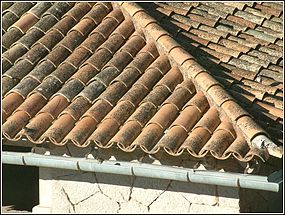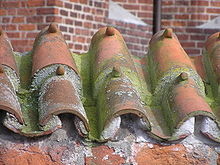- Monk and Nun
-
Monk and Nun is a style of roof similar to Imbrex and tegula, but instead of using a flat tile (tegula) and an arched tile (imbrex), two arched ibrex tiles are used.
The top linking tiles are the monk tiles and the lower layer are the nun tiles. Mortar is often used under the monk tile to firmly attach it to the nun tile as well as providing an extra seal against entry of rain, but it is sometimes omitted. The origin of the name is unknown, but is also known as Priependach.
Another form of Monk and Nun roofing on a church in Kalundborg
This style of roof was, along with imbrex and tegula, developed in ancient times, and is popular around the Mediterranean, France, and, during the Middle Ages it was also popular in Germanic Europe, but was later replaced by Biberschwanz (German: 'Beaver tail' ) roofing, although is still occasionally used, particularly for old and sacred buildings (which would have originally had Monk and Nun roofs).
In modern times this style is popular in the American southwest where it is called Pan and Cover or Mission Style. An easier-to-install variant called S-Tile is essentially the synthesis of a pan tile and a cover tile.
References
- This article incorporates information from the equivalent article on the German Wikipedia.
Gallery
-
An example of Monk and Nun in San Agustin, Gran Canaria
-
An exmple from Plaza de España, Seville, Spain
Categories:- Roofs
- Terracotta
- Ancient Roman pottery
- Ancient Roman architectural elements
- Architectural element stubs
- Architecture stubs
Wikimedia Foundation. 2010.




